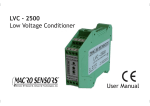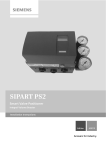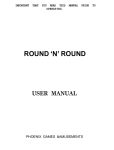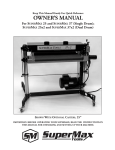Download File - Solartron Metrology
Transcript
BICM - LVDT (Boxed Inline Conditioning Module) For LVDT Transducers only user leaflet Index Section Title Index . . . . . . . . . . . . . . . . . . . . . . . . . . 1 Page 1.0 2.0 Technical Specification . . . . . . . . . . . . . . . 3 3.0 Operational and Set-Up Guide - BICM Kit . . . 6 3.1 Introduction . . . . . . . . . . . . . . . . . . . . . . 6 3.2 Screen Connection . . . . . . . . . . . . . . . . . 8 3.3 Gain Adjustment . . . . . . . . . . . . . . . . . . . 10 3.4 Offset . . . . . . . . . . . . . . . . . . . . . . . . 10 3.5 Set Up Using Fixed Value Resistors . . . . . 11 3.6 Gain Set Up Procedure . . . . . . . . . 13 3.7 Offset Set Up Procedure . . . . . . . . . 14 4.0 5.0 The Case . . . . . . . . . . . . . . . . . . . . . . . . . . 16 6.0 Application Notes . . . . 6.1 Transducer Installation 6.2 Example 1 . . . . . . 6.3 Example 2 . . . . . . Introduction . . . . . . . . . . . . . . . . . 2 The "Why Doesn't it Work Guide" . . . . . . 17 . . . . . . . . . . . . . . . . . . . . . . . . . . . . . . . . . . . . . . . . . . . . . . . . . . . . . . . . . . . . . . 18 18 22 23 Return Of Goods Solartron Sales Offices Index 1 501651 Issue 14.1 1.0: Introduction 1.0: Introduction & Glossary The Boxed Inline Conditioning Module (BICM) is an electronics module that may be used with a wide range of LVDT transducers. Layout and size are designed to allow the BICM to be easily fitted inline with the transducer cable and installed with the minimum of effort (or changed if ready connected to a transducer) The BICM output may be set for a full scale range up to ±10 VDC, offset facilities are provided. The BICM is either powered from a bipolar ±15 VDC supply or a unipolar ±24 VDC supply depending on product type. Ensure that your product is wired up correctly, see section 3. Ensure that you do not apply greater than 15 V to either of the bipolar supply inputs. BICM - Boxed Inline Conditioning Unit Gain - The output voltage per mm of transducer stroke Offset - The output voltage when the transducer core is at null P.C.B. - Printed Circuit Board NPV - Nearest Preferred Value. A resistor selected from a standard range of value (E24, E48, etc.) that is closest to the required value BICM kits are supplied for user connection to an LVDT transducer. 2.0: Introduction 2 501651 Issue 14.1 2.0: Technical Specification Standard BICM Bipolar Supply Unipolar Supply Power Requirement Voltage ±15 V ±1.5 V 24 V ±2.4 V Current ±15 mA nominal 30 mA nominal Transducer Excitation Primary Voltage 2 Vrms nominal Primary Frequency 1 5 kHz typical Primary Current 10 mA nominal Signal Input Input Voltage Range Up to 2.5 Vrms Input Load Resistance 2.0: Technical Specification 100 kW 3 501651 Issue 14.1 2.0: Technical Specification Standard BICM Bipolar Supply Unipolar Supply Signal Output Voltage Output Up to ±10 V Current Output 11 mA Output Ripple <14 mVrms Output Offset 100% <0.03% FRO / oC Temp Co. Gain <0.025% FRO / oC Temp. Co. Offset Warm up Time 15 minutes recommended Linearity 2 (electronics only) <0.1% FRO Bandwidth (-3 dB) 3 250 Hz typical 1 Other frequencies are available on request. 2 The electronics has a specification of <0.1%, the overall linearity is dominated by the transducer. 3 Other bandwidths available on request. 2.0: Technical Specification 44 501651 Issue 14.1 2.0: Technical Specification Standard BICM Bipolar Supply Unipolar Supply Environmental 0 - 70 oC Operation Temperature Range -20 to +85 oC Storage Temperature Range IP Rating IP40 Mechanical and Connections Connections Solder pad or factory fit Enclosure Size 98.5 x 30.5 x 13.0 mm Weight 30 g Material ABS Cable Lengths All specification limits assume a nominal 3 m cable length between transducer and BICM. The BICM can be mounted up to 10 m from the transducer, but this may result in reduced performance. Not all transducers can cope with long cable lengths. Cable from the BICM to the processing unit or display should be limited to 100 m. 2.0: Technical Specification 55 501651 Issue 14.1 3.0: Operational and Set-Up Guide - BICM Kit 3.1: Introduction The BICM kit is supplied with a selection of potentiometers and an output cable allowing users to connect LVDT sensors and set up to their own requirements. Connections are made to the BICM PCB as shown in Fig. 3.1A or Fig. 3.1B below depending on the PCB version. The BICM output is adjustable for GAIN and OFFSET. See the specification for range of adjustments possible. Gain is sometimes called span or range. This control will affect the output voltage at the full transducer stroke. Adjusting the control clockwise will increase the output. Offset is sometimes called DC shift or zero shift. This control may be used to zero the output if mechanically nulling the transducer is not convenient or can provide as much as 100% offset to enable the output to be unipolar ie. 0V to 10 V for full transducer stroke. Adjusting the control clockwise will make output more negative. Adjustment is by means of trimmer potentiometers (also called variable resistor or pots). The BICM will accept fixed value resistors in place of potentiometers. The BICM is designed to accept the following types of potentiometer or resistor:Potentiometer - Standard 3/8in square top adjust type potentiometer, see Fig. 3.1 (ie. Bourns 3299 type). The BICM kit comes complete with four potentiometers. Resistors - 1/4W MRF4 style. 3.0: Operational Guide 6 501651 Issue 14.1 3.0: Operational and Set-Up Guide - BICM Kit Secondary 2 Green Vout Yellow Secondary 1 White 0V (Signal) white R1 RV1 Gain Screen R2 +R4 RV2 Offset R3 -R4 Primary Exc1 Blue Primary Exc 2 Red Fig. 3.1A Connections to PCB - 105186 (Bipolar or Unipolar) SEC2 SEC1 Yellow Green Yellow VOUT 0V White White Screen PRI1 Primary PRI2 Output Signal Screen Blue Blue Green Red Red TRANSDUCER CONNECTIONS -15 V 0V +15 V Power Supply I/O CONNECTIONS Fig. 3.1B Connections to PCB - 103766 (Bipolar only) 3.0: Operational Guide 7 501651 Issue 14.1 3.0: Operational and Set-Up Guide - BICM Kit 3.2: Screen Connection The screen connection is arranged so that the transducer cable screen and I/O cable screen is connected and that some cable strain relief is provided whilst setting up the board. Screens are not connected to 0V on the PCB. Screen and 0V may be connected on the PCB by using a wire link or at the user connection end, for example at the PSU, but it all depends on the installation requirements. Colours are for Solartron MACH 1 5 kHz Series transducers. Check individual transducer data sheets before connecting. If a different polarity output is required secondary connections may be reversed. See application notes. Centre Tap (CT), yellow wire, connection not required. Ensure no loose wires. FIG 4.2 SCREEN CONNECTION 3.2 Screen Connection Fit the potentiometers in the positions indicated in Fig. 3.3. The table below gives suggested values for use with some solartron LVDT's. Once fitted the set up procedure can be followed to give the required output. 3.0: Operational Guide 8 501651 Issue 14.1 3.0: Operational and Set-Up Guide - BICM Kit TRANSDUCER POTENTIOMETER VALUE (ohms) GAIN OFFSET B2.5 B5.0 B10 B15 B25 B50 B100 100K5K 50K 10K 100K5K 100K5K 100K5K 50K10K 50K 10K Top View Side View Transducer Connection End Fit this way round FIG 5.1 COMPONENT INSTALLATION Fig. 3.3 Component Installation 3.0: Operational Guide 9 501651 Issue 14.1 3.0: Operational and Set-Up Guide - BICM Kit 3.3. Gain Adjustment Gain adjustment is best done before offset adjustment. If an OFFSET potentiometer has been fitted then set this to the mid position. GAIN SETUP PROCEDURE 1) Adjust the potentiometer to the approximate mid position, about 12 full turns from either end. 2) Adjust the LVDT core position to give 0V output. 3) Move the core to a full scale position either inwards (+ve output) or outwards (-ve output). Adjust the potentiometer value to give the required full scale output voltage such as + or -10 V. Adjusting the control clockwise will increase the output. 4) Return the core to the null position and check the output. Repeat steps 2 & 3 as required. 3.4. Offset Any offset required is set by simply adjusting the OFFSET potentiometer until the required positive or negative offset is achieved. Adjusting the control clockwise will make the output more negative. Example:- Output required is 0V to +8 V for full transducer stroke (fully out to fully in). Set the gain for an output of 0V ±4 V then apply an offset of +4 V. Applying the required offset can sometimes be difficult if the gain is not correctly set. The application notes may help. If no offset is required it is best not to fit the OFFSET potentiometer. 3.0: Operational Guide 10 501651 Issue 14.1 3.0: Operational and Set-Up Guide - BICM Kit 3.5. Set Up Using Fixed Value Resistors Fit the components into the positions shown in Fig 3.4 once component values have been determined using the set up procedure. The term nearest preferred value (NPV) is used throughout. This is a resistor selected from standard ranges (E24,E48 etc) that most closely matches the value required. Two resistors (in series) may be fitted to allow for more accurate calibration of gain and offset. If only one resistor is required a wire link is fitted in place of the second resistor. Gain adjustment is best done before offset adjustment. If an OFFSET potentiometer is fitted, set this to the mid position. If a resistor is fitted, temporarily disconnect this. If an offset is to be applied take this into account when setting the gain. Example:- Output required is 0V to +10 V for full transducer stroke (fully out to fully in). Set the gain for an output of 0V ±5 V then apply an offset of +5 V. Some suggested start values for resistors are shown in the table below. If the transducer being used is not in the list then start with an arbitrary value such as 50 Kohms. 3.0: Operational Guide 11 501651 Issue 14.1 3.0: Operational and Set-Up Guide - BICM Kit TRANSDUCER APPROXIMATE RESISTOR VALUE (ohms) GAIN OFFSET (+ or -5V) B1.5 B2.5 B5.0 B10 B15 B25 B50 B100 85K 20K 61K 13K 40K 7K5 70K15K 52K11K 51K11K 39K7K5 25K 4K3 Fig 3.4 Resistor Positions 3.0: Operational Guide 12 501651 Issue 14.1 3.0: Operational and Set-Up Guide - BICM Kit 3.6. Gain Set Up Procedure If this procedure is to be used to determine the value of potentiometer required perform up to step (6). The potentiometer value will be the NPV greater than the resistor value determined. 1) Temporarily connect a variable resistance (such as a decade box) to the board as in Fig. 3.5(a). Set the resistor to an initial value as shown in the table. Resistance Box Resistance Box (a) (b) Fig 3.5 Temporary Resistor Connections - Gain 2) Move the core to a full scale position either inwards (+ve output) or outwards (-ve output). Adjust the potentiometer value to give the required full scale output voltage such as + or -10 V. 3) Move the core to the full scale position. Adjust the variable resistor value to give the required full scale output voltage such as + or - 10 V. 4) Return the core to the null position and check the output. Repeat steps 2 & 3 as required. 5) If a single resistor is to be fitted, fit a NPV fixed resistor to position R1. Fit a wire link to position R2. If two resistors are to be used for a more accurate calibration see step (6) 3.0: Operational Guide 13 501651 Issue 14.1 3.0: Operational and Set-Up Guide - BICM Kit 6) Fit a NPV fixed resistor that is just below the value required to position R1. Reconnect the temporary variable resistor to position R2, see Fig 3.6(b). 7) Repeat steps 2 & 3, moving the core between the null position and the full scale position adjusting the variable resistor as necessary to achieve the required output. 8) Substitute a NPV fixed resistor for the temporary variable resistor position R2. 3.7 Offset Set Up Procedure It is assumed that the gain has been set up consistent with the overall required result. 1) Set the transducer core to the null position. If this cannot be determined mechanically then, with no OFFSET resistors connected, adjust the core position for a 0V output. 2) Connect temporary SOT or variable resistors (leads to be kept as short as possible) as shown for the required polarity offset. Fig. 3.6(a) for a positive offset and Fig. 3.6(b) for a negative offset. Resistance Box (a) POSITIVE OFFSET Resistance Box (b) NEGATIVE OFFSET Fig 3.6 Temporary Resistor Connections - Offset 3.0: Operational Guide 14 501651 Issue 14.1 3.0: Operational and Set-Up Guide - BICM Kit 3) Adjust the variable resistance until the required offset is achieved. 4) If a single resistor is to be fitted, fit a NPV fixed resistor to position +R4 or -R4 . Fit a wire link to position R3. If two resistors are to be used for a more accurate calibration see step (5). 5) Fit a resistor with NPV that is just below the required value to position +R4 or -R4. Re-connect the temporary variable resistor to position R3. 6) Repeat steps 1 & 3, moving the core between the null position and the full scale position adjusting the variable resistor as required to achieve the required output. 7) Substitute the temporary variable resistor for a fixed resistor of the nearest preferred value. 3.0: Operational Guide 15 501651 Issue 14.1 4.0: The Case The BICM case comprises two identical halves which are simply clamped around the PCB and connecting cables. Four self tapping screws are used to secure the halves together. Please note each half has a step along the side. The case halves will only mate correctly one way round. DO NOT OVER TIGHTEN THE SCREWS when reassembling the case. The strain relief blades in each half of the case may be removed if not required. If enhanced environmental protection is required it is recommended that a suitable adhesive/sealant is applied to all edges of the case before assembly. A suitable potting agent may also prove effective. Strain Relief Blades Fig 4.1 Case Assembly 4.0: The Case 16 501651 Issue 14.1 5.0: The "Why Doesn't it Work Guide" This is not an exhaustive list of problems but may help cure some of more common problems. FAULT CONDITION NO OUTPUT SUPPLY CURRENT HIGH INSUFFICIENT OUTPUT WRONG POLARITY OUTPUT POSSIBLE CAUSE OF FAULT Power supply Is it connected correctly? Is it turned on? Is there at least ±13.5 VDC at the power supply pads of the bipolar or +21.6 V for unipolar BICM? Transducer Is it connected correctly? Is the transducer functional (perform continuity tests)? Power supply (see NO OUTPUT) Transducer Core not in transducer? Short on primary connection? Short on secondary connection? Is the transducer functional (perform continuity test)? Is the primary drive to transducer correct (compare with specification)? Output load Is the output shorted or wrong load? Power supply Is there at least ±13.5 VDC at the power supply pads of the bipolar or +21.6 V for unipolar BICM? Is there a proper 0V connection? Transducer Is the transducer core able to move the required amount? Setup Is gain and offset set correctly? Have the components been fitted properly (any dry joints)? Transducer Secondary connection wrong way round (swap white and green wires). Set up Voltmeter/indicator connected wrong way round. 5.0: The "Why Doesn't it Work Guide" 17 501651 Issue 14.1 6.0: Application Notes 6.1. Transducer The MACH 1 5 kHz Series range of Transducer coil assemblies are designed for protection against dust and water to IP66, making them suitable for use in harsh environments. Designed to be rugged and yet still cost effective, these devices offer the Customer all the attributes associated with LVDT’s. A variety of combinations and accessories are available as options. 6.1.1. Introduction The MACH 1 5 kHz Series range of transducers operate on the LVDT principal, where movement of a core inside the transducer body is detected by a differential change in output on two secondary coils, the primary coil(s) being energised by an appropriate AC signal. With the core in a central position, the coupling from the primary to each secondary is equal and opposite and therefore cancel out, thus the resultant output voltage is zero. As the core is displaced further into one secondary, its voltage increases proportionally and the other secondary voltage decreases, hence the output changes in magnitude and phase in proportion to movement in either direction from null. The red and white connections are in phase for inward movement (ie. towards the cable end). The output signal depends on both core movement and energisation voltage and is expressed as a sensitivity in mV output / V energising / mm travel. 6.1.2. Installation LVDT transducers generally are a reliable and proven technology that is well established in all areas of manufacturing and control industries. The majority of the associated problems experienced with their application and use are totally avoidable, particularly if sufficient thought is given during the initial design stages of equipment, to the positioning and clamping methods employed for these feedback elements. LVDT’s being of inductive nature are susceptible to some degree to the influence of magnetic fields and therefore should be positioned well away from electric motors, relays and permanent magnets, where this is not possible then magnetic shielding should be considered as an alternative. Clamping of the coil assembly should be carefully considered, some example methods are shown overleaf. Ideally the body of the transducers should be clamped centrally in a pinch or yoke type clamp, manufactured from a low conductivity, non-magnetic material, if this is not possible then the introduction of a non-metallic bush between body and clamp is a preferred alternative. 6.0: Application Notes 18 501651 Issue 14.1 6.0: Application Notes 6.1.2. Installation (continued) Irrespective of clamping method care must be taken not to overtighten retaining screws as distortion of the body may prove damaging to the integrity of the transducer and adversely affect the geometry of the installation. If the LVDT is to be mounted on equipment subject to high ”g” then dependent on the direction of these forces, it may be advantageous to consider end to end clamping in preference to over body clamping. The magnetic core supplied with each transducer has been manufactured and heat treated to achieve the optimum magnetic performance, any subsequent handling of the core which results in stress being imparted will render the calibration void, this includes overtightening of the core during installation onto its carrier. Hand tightening and retention by means of a suitable thread locking anaerobic retainer is the recommended procedure. 6.1.3. Cores The standard core supplied with each transducer incorporates an M4 x 0.7 x 12 mm deep female thread at both ends for mounting onto a carrier. An alternative 6-40 UNF female thread is available as a standard option upon request. 6.1.4. Carriers A standard length carrier is available for each model of transducer, manufactured from 316 stainless steel and incorporating an M4 x 0.7 x 10 mm long male thread for attachment to the standard core and an M4 x 0.7 x 20 mm male thread for attachment to the fixture. 6.1.5. Guided Carrier MOUNTING Normal mounting methods apply (see section 6.1.2. on Installation). Careful consideration should be given to alignment, the carrier must be able to move freely within the transducer core. Side force should be kept to a minimal level. MAINTENANCE: Check for free movement of the carrier when in the vertical plane. Lubrication is provided via an oilite bush which is impregnated with molybdenum disulphide and in normal usage is maintenance free. 6.0: Application Notes 19 501651 Issue 14.1 6.0: Application Notes 6.1.6. Ball Tip This option is for use with the Guided Carrier and is attached via an adapter fitted to the threaded end of the core carrier. Side forces which may exert undue pressure and flex the carrier must be avoided. 6.1.7. Rod End Bearings MOUNTING: With the exception of the B100 the Transducer may be mounted in an axis; it is recommended that the rear rod end bearing (near cable exit) is mounted on the static component. The B100 because of the increase in weight may exhibit bowing of the carrier and therefore mounting in the horizontal plane should either be avoided or additional support given to the body. This option is used with the guided core. MAINTENANCE: Rod end bearings are supplied pre-lubricated with mineral oil; for higher temperature applications the use of a molybdenum disulphide impregnated oil is recommended and your representative should be consulted about the maximum temperature. Periodic inspection of locking screws and nuts etc. is advisable depending upon the Customers application. Rod end bearings should be able to move freely and have minimal side play. 6.1.8. Cable Solartron Metrology cable is specially manufactured to optimise performance with respect to temperature, chemical resistance, flex life, abrasion resistance and electrical performance. However, no single cable design can fulfil every known requirement and by taking a few simple precautions cable failure can be avoided. In flexture conditions then a minimum bend radius of 150 mm should be maintained. Avoid contact with sharp edges and rough surfaces and inspect at periodic intervals. Excessive cable runs may alter the output characteristics, if in doubt consult your representative. 6.0: Application Notes 20 501651 Issue 14.1 6.0: Application Notes IF POSSIBLE CENTRALISE L.V.D.T. NON-METALLIC SPLIT (TUFNOL) BUSH FOR USE WITH METALLIC CLAMP Fig 6.1 Examples of Clamping Methods 6.0: Application Notes 21 501651 Issue 14.1 6.0: Application Notes 6.2. Example 1 B15 TRANSDUCER ±15 mm stroke (30 mm total stroke) BICM output ±10 V output, no offset 1) Fit the 100 k potentiometer to the GAIN position on the BICM board. 2) No offset is required so the 50 k potentiometer is NOT fitted to the GAIN position on the BICM board. 3) Connect the transducer to the BICM according to Fig. 3.1. 4) Connect the output BICM to the display instrument, in this case a voltmeter on the DC range as shown in Fig. 6.1. Display (ie. Voltmeter) . B.I.C.M. SOLARTRON Power Supply +15V 0V Core Carrier -15mm 0 B15 Transducer +15mm -15V Unipolar supply connections shown Fig 6.2 5) Move the transducer core to the approximate null position, half way along the transducer bore. 6) Turn the power supply on. A small output will probably be indicated on the voltmeter (unless the core has been placed exactly at null). 6) Adjust the core position until the voltmeter reads 0V. 6.0: Application Notes 22 501651 Issue 14.1 6.0: Application Notes 6.2. Example 1 (continued) 7) Move the core 15 mm inwards from the null position. The voltmeter should indicate a Positive increase in output. 8) Adjust the GAIN potentiometer clockwise until +10 V is indicated on the voltmeter. 9) Move the core back to the null position then repeat steps (6) to (8) until satisfied with the calibration. Move the core 15 mm outwards and check that -10 V is indicated on the voltmeter. 6.3. Example 2 B2.5 TRANSDUCER ±2.5 mm stroke (5 mm total stroke) BICM output 0 TO 5 V OUTPUT OVER 5 mm (ie ±2.5 V output plus 2.5 V offset) 1) Fit the 100 k potentiometer to the GAIN position on the BICM board. The OFFSET potentiometer will be fitted later. 2) Connect the transducer to the BICM according to Fig. 3.1 3) Connect the output BICM to the display instrument, in this case a voltmeter on the DC range as shown in the diagram of the last example. 4) Move the transducer core to the approximate null position, half way along the transducer bore. 5) Turn the power supply on. A small output will probably be indicated on the voltmeter (unless the core and OFFSET potentiometer are exactly at null). If the offset pot has already been fitted, see USEFUL HINTS (4). Adjust the core position until the voltmeter reads 0V. 8) Move the core 2.5 mm inwards from the null position. The voltmeter should show a positive increase in output. 9) Adjust the GAIN potentiometer clockwise until +2.5 V is indicated on the voltmeter. 9) Move the core back to the null position then repeat (6) to (8) until satisfied with the calibration. Move the core 2.5 mm outwards and check that -2.5 V is indicated on the voltmeter. The transducer has now been calibrated for ±2.5 V for 5 mm of movement. 10)Fit the 5 k potentiometer to the GAIN position on the BICM board and set the potentiometer to the approximate mid position. 6.0: Application Notes 23 501651 Issue 14.1 6.0: Application Notes 6.3. Example 2 (continued) 11)For a 0 to 5 V output simply adjust the OFFSET potentiometer until the -2.5 V reading on the voltmeter shows 0V. If the core is moved to the mechanical null position +2.5 V should be indicated and +5 V at the fully out position. 6.4. Some Useful Hints 1) If no offset facility is required it is best not to fit any OFFSET components. This makes calibration much easier. 2) If an opposite polarity output is required, ie a -ve output for an inward core movement the secondary connections to the BICM may be reversed (white and green wires for a Solartron MACH 1 5 kHz Series transducer). 3) If the BICM is to be placed in a position where it may be subject to high levels of vibration then using resistors for calibration is advised as potentiometers may shift. 4) If an offset potentiometer is fitted an accurate electrical null can easily be found. Put a temporary shorting link across the transducer secondary by connecting the SEC1 and SEC2 pads on the BICM board. Adjust the OFFSET potentiometer to give an accurate 0V on the voltmeter. Now remove the temporary short. Best performance will be achieved if resistors are used to set gain and offset. Potentiometers whilst being of high quality have a poorer temperature coefficient than resistors. Output noise and stability are also improved by using resistors. 6.0: Application Notes 24 501651 Issue 14.1



































